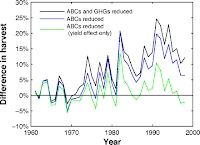Monitoring of Atmospheric Aerosols Using MISR
 NASA launched its first Earth Observing System satellite Terra in May 1999 with five different sensors onboard to monitor and study earth-atmosphere system. MISR is one of the instruments, which is primarily designed to study aerosols and clouds. More on MISR instrument is given in previous post by Harish in the same blog. Since the launch, MISR is providing good quality data of various aerosol properties over global ocean and land. Multi-angle capability of MISR enables retrieval of aerosol properties over both dark and bright targets, which is not available from other sensors such as MODIS. The most important parameter in aerosol research is aerosol optical thickness (AOT), which indirectly tells us columnar loading of aerosols in the earth-atmosphere system. Validation exercise shows that 67% time AOT are within ±0.05 or 20% of AEROENT AOT (Kahn et al., 2005, Abdou et al., 2005, Christopher and Wang, 2004, Martonchik et al., 2004 and Jiang et al., 2006). Also, the accuracies are higher over clean oceans relative to desert sites over land. Apart from AOT, MISR also retrieve single scattering albedo (SSA), angstrom coefficient, and size segregated AOTs, although these parameters are still under validation stage. MISR data have been used in several research studies for various purposes. Recently, MISR visible images have been used to map the path of smoke plumes coming out from world trade center after September 11, 2001 incident (for more details click here). MISR along with other radiation data sets also have been used in estimating direct radiative effects of aerosols in shortwave and longwave part of the solar spectrum (Zhang and Christopher et al., 2003). Several recent research studies have shown the potential of MISR aerosol products in monitoring and forecasting particulate matter air pollution over global urban areas (Liu et al., 2004 and Donkelaar et al., 2006). MISR is very useful in monitoring aerosol over bright targets where MODIS does not provide retrieval. The biggest disadvantage of MISR over MODIS is its narrow swath width (360km), which make global coverage in every 8-9 days compared to MODIS with global coverage in 1-2 days.
NASA launched its first Earth Observing System satellite Terra in May 1999 with five different sensors onboard to monitor and study earth-atmosphere system. MISR is one of the instruments, which is primarily designed to study aerosols and clouds. More on MISR instrument is given in previous post by Harish in the same blog. Since the launch, MISR is providing good quality data of various aerosol properties over global ocean and land. Multi-angle capability of MISR enables retrieval of aerosol properties over both dark and bright targets, which is not available from other sensors such as MODIS. The most important parameter in aerosol research is aerosol optical thickness (AOT), which indirectly tells us columnar loading of aerosols in the earth-atmosphere system. Validation exercise shows that 67% time AOT are within ±0.05 or 20% of AEROENT AOT (Kahn et al., 2005, Abdou et al., 2005, Christopher and Wang, 2004, Martonchik et al., 2004 and Jiang et al., 2006). Also, the accuracies are higher over clean oceans relative to desert sites over land. Apart from AOT, MISR also retrieve single scattering albedo (SSA), angstrom coefficient, and size segregated AOTs, although these parameters are still under validation stage. MISR data have been used in several research studies for various purposes. Recently, MISR visible images have been used to map the path of smoke plumes coming out from world trade center after September 11, 2001 incident (for more details click here). MISR along with other radiation data sets also have been used in estimating direct radiative effects of aerosols in shortwave and longwave part of the solar spectrum (Zhang and Christopher et al., 2003). Several recent research studies have shown the potential of MISR aerosol products in monitoring and forecasting particulate matter air pollution over global urban areas (Liu et al., 2004 and Donkelaar et al., 2006). MISR is very useful in monitoring aerosol over bright targets where MODIS does not provide retrieval. The biggest disadvantage of MISR over MODIS is its narrow swath width (360km), which make global coverage in every 8-9 days compared to MODIS with global coverage in 1-2 days.Five Years of MISR Global Aerosol Observations
References:
Kahn, R., B. Gaitley, J. Martonchik, D. Diner, K. Crean, and B. Holben (2005). Multiangle Imaging SpectroRadiometer (MISR) global aerosol optical depth validation based on two years of coincident AERONET observations. J. Geophys. Res. - Atmospheres, doi:jd004706R, 110 (D10): Article No. D10S04 MAR 9 2005. [Abstract] [Full text 680 KB]
Abdou, WA, Diner, DJ, Martonchik, JV Bruegge, CJ, Kahn, RA, Gaitley, BJ, Crean, KA, Remer, LA, Holben, B, (2005). Comparison of coincident Multiangle Imaging Spectroradiometer and Moderate Resolution Imaging Spectroradiometer aerosol optical depths over land and ocean scenes containing Aerosol Robotic Network sites. J. Geophys. Res., Atmos., 110 (D10), D10S07, pp. 11967-76. [Abstract] [Full text 1584 KB]
Christopher SA, Wang J (2004). Intercomparison between multi-angle imaging spectroradiometer (MISR) and sunphotometer aerosol optical thickness in dust source regions over China: implications for satellite aerosol retrievals and radiative forcing calculations. Tellus Series B-Chemical and Physical Meteorology. 56 (5): 451-456 NOV 2004.[Abstract]
Martonchik, J. V., D. J. Diner, R. Kahn, B. Gaitley, and B. N. Holben (2004), Comparison of MISR and AERONET aerosol optical depths over desert sites, Geophys. Res. Lett., 31, L16102, doi:10.1029/2004GL019807. [Abstract] [Full text 256 KB]
Donkelaar, V. A., R. V. Martin, and R. J. Park (2006), Estimating ground-level PM2.5 using aerosol optical depth determined from satellite remote sensing, J. Geophys. Res., 111, D21201, doi:10.1029/2005JD006996.








